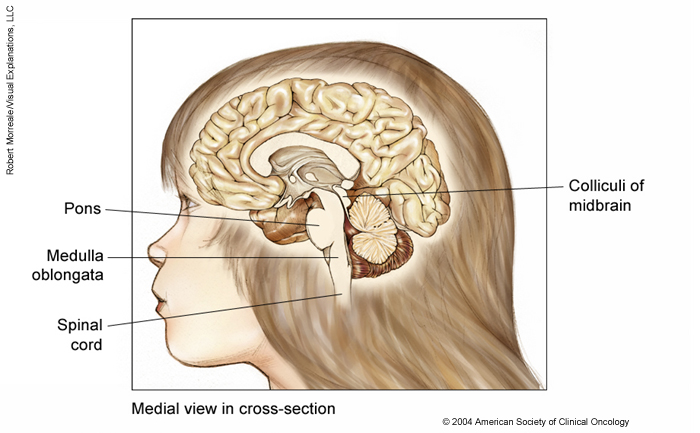ON THIS PAGE: You will find some basic information about childhood brain stem glioma and the parts of the body it may affect. This is the first page of Cancer.Net’s Guide to Childhood Brain Stem Glioma. Use the menu to see other pages. Think of that menu as a roadmap for this entire guide.
About the brain stem
The brain stem connects the brain to the spinal cord. The brain stem is the lowest portion of the brain, located above the back of the neck. It controls many of the body’s basic functions, such as motor skills, sensory activity, coordination and walking, the beating of the heart, and breathing. It has 3 parts:
-
The midbrain, which develops from the middle of the brain
-
The medulla oblongata, which connects to the spinal cord
-
The pons, which is located between the medulla oblongata and the midbrain
About brain stem glioma
Brain stem glioma is a type of central nervous system (CNS; brain and spinal cord) tumor. This type of tumor begins when healthy cells in the brain stem change and grow out of control, forming a mass called a tumor. A tumor can be cancerous or benign. A cancerous tumor is malignant, meaning it can grow and spread to other parts of the body. A benign tumor means the tumor can grow but will not spread. A glioma is a tumor that grows from a glial cell, which is a supportive cell in the brain.
Usually, by the time brain stem glioma is diagnosed, it is most often diffuse. This means it has spread freely through the brain stem. This type of tumor is typically very aggressive, meaning that it grows and spreads quickly. A small percentage of brain stem tumors are very localized, called focal tumors. A focal tumor is often less likely to grow and spread quickly.
Most brain stem tumors develop in the pons and grow in a part of the brain stem where it can be difficult to perform surgery, making brain stem glioma challenging to treat (see the Types of Treatment section).
Brain stem glioma occurs most commonly in children between the ages of 5 and 10 years old. This section covers brain stem glioma diagnosed in children. Read more about brain tumors in adults.

Looking for More of an Introduction?
If you would like more of an introduction, explore this related item. Please note that this link will take you to another section on Cancer.Net:
-
Cancer.Net En Español: Read about brain stem glioma in Spanish. Infórmase sobre el glioma de tronco encefálico en español.
-
Find a Cancer Doctor. Search for a cancer specialist in your local area using this free database of doctors from the American Society of Clinical Oncology (ASCO).
-
Cancer Terms. Learn what medical phrases and terms used in cancer care and treatment mean.
The next section in this guide is Statistics. It helps explain the number of children who are diagnosed with brain stem glioma and general survival rates. Use the menu to choose a different section to read in this guide.
